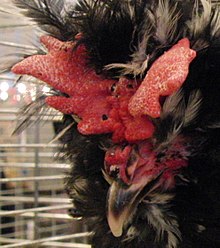Houdan chicken
 Detail of the head of a cock, showing the characteristic butterfly comb | |
| Other names | French: Poule de Houdan |
|---|---|
| Country of origin | France |
| Standard | Standard-sized (in French) Bantam (in French) |
| Use | meat, eggs, fancy |
| Traits | |
| Weight |
|
| Egg color | white |
| Comb type | shaped like a butterfly or oak-leaf; OR like a capital "V" |
| Classification | |
| APA | continental[1] |
| ABA | all other comb clean legged[1] |
| EE | yes[2] |
| PCGB | rare soft feather: heavy[3] |
| Notes | |
| five-toed | |
| |

The Houdan or Poule de Houdan is an old French breed of domestic chicken, belonging to the group of crested chicken. It is named for its area of origin, the commune of Houdan, in the département of Yvelines to the west of Paris. The Houdan has a double comb; standardized in France, Europe and the UK to an unusual butterfly shape, or in the US and Canada to a "V" comb not unlike the Crèvecœur. It is one of the few breeds which have five toes rather than the usual four.
History[]
The origins of the Houdan breed are unknown; as they predate modern agricultural writing, little can be said with certainty. The breed was described in detail in 1858.[4] The Houdan combines a number of distinctive features, which in the nineteenth century gave rise to speculation about the breeds that might have contributed to its development.[5] Cross-breeding with the Crèvecœur or perhaps the Polish was suspected to have given the Houdan its crest, and with either the Dorking or a native five-toed fowl of France was thought have to resulted in its fifth toe.
It was first imported into England in 1850,[6] and to North America in 1865, where it appeared in the first edition of the American Standard of Perfection in 1874.[7]: 121
Characteristics[]
Houdans have small earlobes and wattles, a backward flowing crest, and facial feathering consisting of a beard and muffing near the ears. On hens, comb and wattles are sometimes completely obscured by the feathering. Houdan combs are V-shaped in the American standard, and butterfly-shaped in the British, Australian and French standards.
The most common colour variety is mottled (or caillouté, "pebbled" in France), a pattern of black with white spotting. In the past there was a lighter variation of the mottled pattern; in the 1800s, it may have been more similar to the splashy mixture of white and black which today is called Exchequer.[5] Four other colour varieties are recognised in the Poultry Standard for Europe of the Entente Européenne d'Aviculture et de Cuniculture: black, cuckoo, pearled grey, and white.[2]
The Houdan is a light breed: cocks weigh 2.5–3 kg and hens 2–2.5 kg.[8] A bantam Houdan was created in Britain in the 1940s, and further developed in Germany.[citation needed]
Use[]
Originally a dual-purpose fowl kept for both eggs and meat, and for part of the 1800s one of France's main meat breeds, the Houdan today is primarily a rare show bird. However, with a fairly quick rate of maturation and the ability to lay a respectable number of white eggs, it is still occasionally kept in backyard flocks.
References[]
| Wikimedia Commons has media related to Houdan chicken. |
- ^ Jump up to: a b APA Recognized Breeds and Varieties: As of January 1, 2012. American Poultry Association. Archived 4 November 2017.
- ^ Jump up to: a b Liste des races et variétés homologuée dans les pays EE (28.04.2013). Entente Européenne d’Aviculture et de Cuniculture. Archived 16 June 2013.
- ^ Breed Classification. Poultry Club of Great Britain. Archived 12 June 2018.
- ^ Charles Emile Jacque (1858). Le poulailler: monographie des poules indigènes et exotiques, aménagements, croisements élève, hygiène, maladies, etc. (in French). Paris: Librairie agricole de la maison rustique.
- ^ Jump up to: a b Charles Lee (1874). A Practical Guide to the Breeding, Feeding, Rearing and General Management of the Houdan Fowl. London: W. Hawkins. p. 11.
- ^ Victoria Roberts (2008). British poultry standards: complete specifications and judging points of all standardized breeds and varieties of poultry as compiled by the specialist breed clubs and recognised by the Poultry Club of Great Britain. Oxford: Blackwell. ISBN 9781405156424. p. 121.
- ^ Carol Ekarius (2007). Storey's Illustrated Guide to Poultry Breeds. North Adams, Massachusetts: Storey Publishing. ISBN 9781580176675.
- ^ Standard de la Houdan (in French). Houdan–Faverolles Club de France. Accessed August 2014.
Further reading[]
- Graham, Chris (2006). Choosing and Keeping Chickens. 2-4 Heron Quays London E14 4JP: Octopus Publishing. ISBN 978-0-7938-0601-0.CS1 maint: location (link)
- Hobson, Jeremy; Celia Lewis (2007). Keeping Chickens. 4700 E Galbraith rd, Cincinnati OH 45236: David and Charles Ltd. ISBN 0-7153-2567-1.CS1 maint: location (link)
- Périquet, Jean-Claude (2006). Coqs et Poules: les Races Françaises. Éditions Rustica. ISBN 978-2-84038-613-1.
- Russell, Craig (2000). "Old French Breeds: Houdans and Crevecoeurs". SPPA Bulletin. 5 (2): 3–4.
- Conservation Priority Breeds of the Livestock Conservancy
- Chicken breeds
- Chicken breeds originating in France